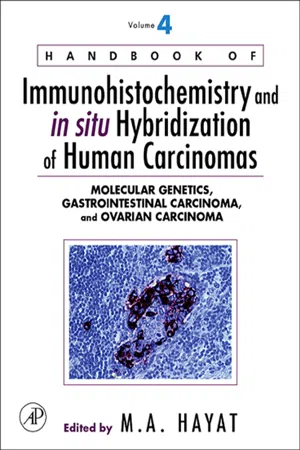
Handbook of Immunohistochemistry and in situ Hybridization of Human Carcinomas
Molecular Genetics, Gastrointestinal Carcinoma, and Ovarian Carcinoma
- 608 pages
- English
- ePUB (mobile friendly)
- Available on iOS & Android
Handbook of Immunohistochemistry and in situ Hybridization of Human Carcinomas
Molecular Genetics, Gastrointestinal Carcinoma, and Ovarian Carcinoma
About This Book
Classical histology has been augmented by
immunohistochemistry (the use of specific antibodies to stain particular molecular species in situ). Immunohistochemistry has allowed the identification of many more cell types than could be visualized by classical histology, particularly in the immune system and among the scattered hormone-secreting cells of the endocrine system. This book discusses all aspects of immunohistochemistry and in situ hybridization technologies and the important role they play in reaching a cancer diagnosis. It provides step-by-step instructions on the methods of additional molecular technologies such as DNA microarrays, and microdissection, along with the benefits and limitations of each method.* The only book available that translates molecular genetics into cancer diagnosis
* Methods were developed by internationally-recognized experts and presented in step-by-step manner
* Results of each Immunohistochemical and in situ hybridization are presented in the form of color illustrations
Frequently asked questions
Information
Role of Immunohistochemical Expression of DNA Methyltransferase 1 Protein in Gastric Carcinoma
Introduction
Materials
Methods
Table of contents
- Cover image
- Title page
- Table of Contents
- Handbook of Immunohistochemistry and in situ Hybridization of Human Carcinomas
- Front Matter
- Copyright page
- Dedication
- Authors and Coauthors of Volume 4
- Foreword
- Preface
- Selected Definitions
- Classification Scheme of Human Cancers
- Identification of Tumor-Specific Genes
- The Post-Translational Phase of Gene Expression in Tumor Diagnosis
- Role of Tumor Suppressor BARD1 in Apoptosis and Cancer
- Angiogenesis, Metastasis, and Epigenetics in Cancer
- Can Effector Cells Really “Effect” an Anti-Tumor Response as Cancer Therapy?
- Circulating Cancer Cells
- Circulating Cancer Cells: Flow Cytometry, Video Microscopy, and Confocal Laser Scanning Microscopy
- Gastrointestinal Carcinoma: An Introduction
- Role of Immunohistochemical Expression of p53 in Gastric Carcinoma
- Role of Immunohistochemical Expression of p53 and Vascular Endothelial Growth Factor in Gastric Carcinoma
- Role of Immunohistochemical Expression of p150 in Gastric Carcinoma: The Association with p53, Apoptosis, and Cell Proliferation
- Role of Immunohistochemical Expression of Ki-67 in Adenocarcinoma of Large Intestine
- Role of Immunohistochemical Expression of KIT/CD117 in Gastrointestinal Stromal Tumors
- Role of Immunohistochemical Expression of BUB1 Protein in Gastric Cancer
- Role of Immunohistochemical Expression of Epidermal Growth Factor in Gastric Tumors
- Role of Immunohistochemical Expression of Beta-Catenin and Mucin in Stomach Cancer
- Loss of Cyclin D2 Expression in Gastric Cancer
- Role of Immunohistochemical Expression of E-Cadherin in Diffuse-Type Gastric Cancer
- Role of Immunohistochemical Expression of Adenomatous Polyposis Coli and E-Cadherin in Gastric Carcinoma
- Immunohistochemical Expression of Chromogranin A and Leu-7 in Gastrointestinal Carcinoids
- Role of Immunohistochemical Expression of MUC5B in Gastric Carcinoma
- Angiogenin in Gastric Cancer and Its Roles in Malignancy
- Role of Helicobacter pylori in Gastric Cancer
- Protein Alterations in Gastric Adenocarcinoma
- Vesicle Proteins in Neuroendocrine and Nonendocrine Tumors of the Gastrointestinal Tract
- Role of Immunohistochemical Expression of Caspase-3 in Gastric Carcinoma
- Role of Immunohistochemical Expression of PRL-3 Phosphatase in Gastric Carcinoma
- Role of Immunohistochemical Expression of DNA Methyltransferase 1 Protein in Gastric Carcinoma
- Role of Immunohistochemical Expression of Cytoplasmic Trefoil Factor Family-2 in Gastric Cancer
- Role of Immunohistochemical Expression of Cytokeratins in Small Intestinal Adenocarcinoma
- Quantitative Immunohistochemistry by Determining the Norm of the Image Data File
- Ovarian Carcinoma: An Introduction
- Methods for Detecting Genetic Abnormalities in Ovarian Carcinoma Using Fluorescence in situ Hybridization and Immunohistochemistry
- Role of Immunohistochemical Expression of HER2/neu in High-Grade Ovarian Serous Papillary Cancer
- Role of Immunohistochemical Expression of BRCA1 in Ovarian Carcinoma
- Role of BRCA1/BRCA2 in Ovarian, Fallopian Tube, and Peritoneal Papillary Serous Carcinoma
- K-Ras Mutations in Serous Borderline Tumors of the Ovary
- Role of Immunohistochemical Expression of Ki-67 in Ovarian Carcinoma
- Role of Expression of Estrogen Receptor β, Proliferating Cell Nuclear Antigen, and p53 in Ovarian Granulosa Cell Tumors
- Role of Immunohistochemical Expression of Cyclooxygenase-2 in Ovarian Serous Carcinoma
- Role of Immunohistochemical Expression of Cyclooxygenase and Peroxisome Proliferator–Activated Receptor γ in Epithelial Ovarian Tumors
- CDX2 Immunostaining in Primary and Secondary Ovarian Carcinomas
- Epithelial Ovarian Cancer and the E-Cadherin–Catenin Complex
- Role of Cytokeratin Immunohistochemistry in the Differential Diagnosis of Ovarian Tumors
- Role of Immunohistochemical Expression of Cytokeratins and Mucins in Ampullary Carcinomas
- Role of Integrins in Ovarian Cancer
- Role of Immunohistochemical Expression of Vascular Endothelial Growth Factor C and Vascular Endothelial Growth Factor Receptor 2 in Ovarian Cancer
- Use of Microarray in Immunohistochemical Localization of SMAD in Ovarian Carcinoma
- Role of Immunohistochemical Expression of Fas in Ovarian Carcinoma
- Role of Immunohistochemical Expression of Lewis Y Antigen in Ovarian Carcinoma
- Role of Immunohistochemical Expression of ETS-1 Factor in Ovarian Carcinoma
- Role of MCL-1 in Ovarian Carcinoma
- Role of Elf-1 in Epithelial Ovarian Carcinoma: Immunohistochemistry
- Role of Immunohistochemical Expression of OCT4 in Ovarian Dysgerminoma
- Immunohistochemical Validation of B7-H4 (DD-O110) as a Biomarker of Ovarian Cancer: Correlation with CA-125
- Role of Immunohistochemical Expression of Alpha Glutathione S-Transferase in Ovarian Carcinoma
- Role of Immunohistochemical Expression of Aminopeptidases in Ovarian Carcinoma
- Expression of Angiopoietin-1, Angiopoietin-2, and Tie2 in Normal Ovary with Corpus Luteum and in Ovarian Carcinoma
- The Role of Immunohistochemical Expression of 1,25-Dihydroxyvitamin-D3-Receptors in Ovarian Carcinoma
- Role of Immunohistochemical Expression of Antigens in Neuroendocrine Carcinoma of the Ovary and Its Differential Diagnostic Considerations
- Role of Immunohistochemistry in Elucidating Lung Cancer Metastatic to the Ovary from Primary Ovarian Carcinoma
- Index